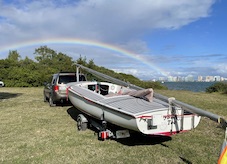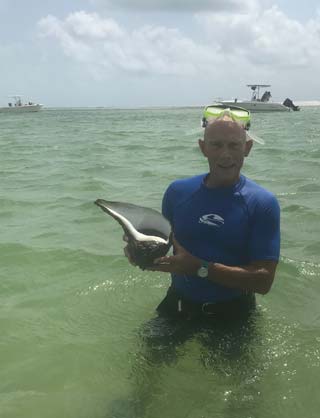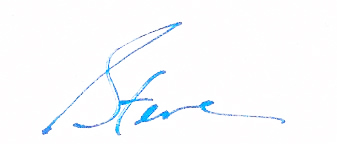|
LEARNER OUTCOMES
Half-day or full-day lessons for small groups (3 max!) are 'hands-on' by design with an experienced coach at your side. A Sail2Learn lesson begins with a 2 hour Classroom Orientation the evening prior to your Afloat Session. The orientaion includes discussion of your personal sailing goals, a tour of the parts of a sailing sloop, a review of the expected weather forecast, completing a USCG Float Plan, a discussion (and simulation - using a model) of wind theory and basic sailing maneuvers, practicing tying a few basic seaman's knots, securing lines to a variety of cleats and winches, and how to "throw lines" at the dock. In your afloat session you will learn all required to effectively and safely handle a daysailer including:
|
1st Half-Day Outcomes
- review weather forecast; wind direction and velocity, and tidal phases,
- identify current conditions using 'windicators,'
- identify local landmarks for use as visual bearings,
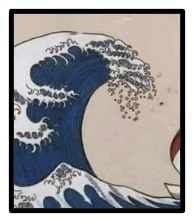 successfully rig (assemble standing and running rigging and step (raise) the mast using a safety bridle system) a daysailer which entails learning to assemble spars (mast and boom), securing sails to control lines,(halyard, topping lift, outhaul, boom vang, mainsheet, jib sheets) and fittings using hardware and tying proper seaman's knots. Here we will review >sailing lingo ;-) as they learn to again identify parts of the boat. [Practice here] | [Rigging Map] successfully rig (assemble standing and running rigging and step (raise) the mast using a safety bridle system) a daysailer which entails learning to assemble spars (mast and boom), securing sails to control lines,(halyard, topping lift, outhaul, boom vang, mainsheet, jib sheets) and fittings using hardware and tying proper seaman's knots. Here we will review >sailing lingo ;-) as they learn to again identify parts of the boat. [Practice here] | [Rigging Map]- hoist mainsail and properly connect lazy jack lines,
- lower and flake mainsail atop boom within lazy jacks "nest,"
- secure mainsail to boom with sailties or bungee cords,
- launch boat from trailer via boat ramp,
- hoist main and jib, and deploy rudder and centerboard (and outboard if needed),
- sail, paddle or motor out thru channel away from dock into windy space,
- point out common navigational markers (red & green channel markers; fixed and floating, lit and unlit) and other aids to navigation - and their informational value to boaters,
- helm (setting course (steering on a point of sail) and speed (increase/decrease), balancing load, and directing crew,
- recommended communication methods between helmsman and crew including commands, responses, and hand signals,
- crew (handling jib sheets, outhaul, downhaul, boom vang, reefing lines, halyards, centerboard (anchor/rode, dock lines too), under sail - on all points of sail - learning to execute tacks and gybes smoothly) with BOTH mainsail and jib,
- execute proper helming transition from windwind to new windward - on both starboard and port sides,
- identify visual bearings, waypoints, and viable points of sail while avoiding getting caught in irons - and if it happens (and it will!), quickly recovering by backing the mainsail,
- make a beach landing (the Flying Scot with a swing centerboard and kick-up rudder has a shallow (8") draft and is "beachable" in low surf),
- drop and flake (accordion fold) jib sail onto foredeck,
- drop mainsail and flake within lazy jacks,
- drop and set anchor,
- successfully relaunch from beach/anchor,
- plan and execute return to dock under sail or auxiliary power safely - includes throwing and securing lines at the dock,
|
2nd Half-Day Outcomes
- using a local chart - identify waterways/channels and potential hazards,
- heave to & lash tiller to temporarily sail without active helmsman,
- identify our current location by both chart landmarks (on-water aids to navigation markers and common physical landmarks like bridges, buildings, radio towers, etc.) and by GPS coordinates,
- take a bearing via hand compass
- using a handheld VHF marine radio to communicate effectively with others on the water - including;
- accessing weather forecasts,
- making hailing calls to properly request;
- a radio test,
- a bridge opening,
- emergency assistance.
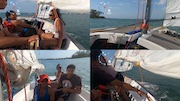
Lesson Montage |
- introduce the COLRegs "Rules of the Road" (practices for preventing collisions at sea) for use when encountering other vessels on the water,
- recover a "MOB" (man-over-board). No, not you - or your partner(s))! ;-) It's a drill! Using the Figure 8 technique and the "MOB!, Point, Throw Flotation" mantra we will "rescue" a red kickboard with an attached yellow crabpot float... with a goal of making a smooth pick-up in less than 90 seconds!. It's an important skill to master as a true MOB in rough and cool seas can be exceedingly challenging and have potentially tragic outcomes.
- while on a downwind point of sail (broad reach or run);
- deploy jib and mainsail in "wing and wing" sail arrangement to opposite sides of centerline,
- "blanket" the jib sail with mainsail and drop and secure jib on foredeck
- review of USCG safety requirements for 16-26' sailboats; PFDs, fire extinguishers, distress signals used to call for assistance, navigation lights, etc.
- identify other sailboat(s) we see; on moorings, sailing, or on the docks by their rig design,
- reef or reduce mainsail using jiffy reefing at first and/or second reef points. If we are out in strengthening winds we will learn the proper proceedure to reduce windage of the mainsail so that we are not overpowered. This is an important skill for stormy conditions.
- douse (downhaul, flake and stow) regular jib sail and replace with storm jib.
- effectively approach and pick-up a mooring ball,
- singlehanding (handling helming AND crewing roles solo - yes! It's a handful!), and
-
recover from capsize (optional... the Flying Scot is a very stable vessel and she is difficult(!) to capsize, BUT we will - if students desire it! The recovery from capsize is a challenging skill to master but is a great confidence-builder),
- many of the 1st half-day drills as desired by learner and/or directed by your coach,
- plan and execute return to dock under sail or auxiliary power safely - includes throwing and securing lines at the dock,
- load boat back onto trailer & and de-rig for transport.
|
|
After each sailing session we will make a summary self-assessment using the Sail2Learn Goals Checklist to identify future goals.
ADDITIONALLY - if you are interested in a night sail... when weather conditions are right - including clear skies and a near-full moon Sail2Learn offers night sailing lessons. These are follow-up lessons for a half-day or full-day sailing lesson. We focus on using a GPS charting app and the night time sailing tools (flashlights, headlamps, nav lights) and skills required for this challenging (imagine doing the MOB drill (flashing strobe light attached to float) at night!) type of sailing. Another great confidence builder!
|
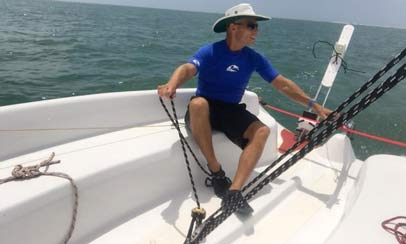
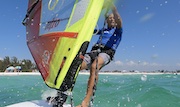


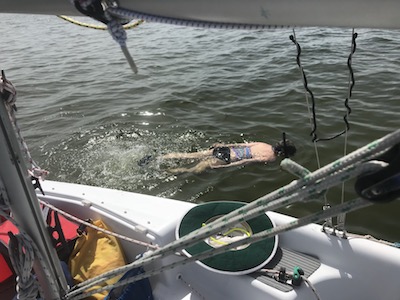
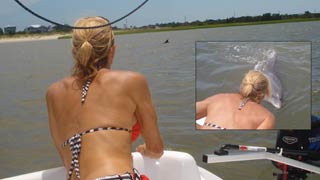

 So! You've decided to become a sailor. :-)
So! You've decided to become a sailor. :-)
